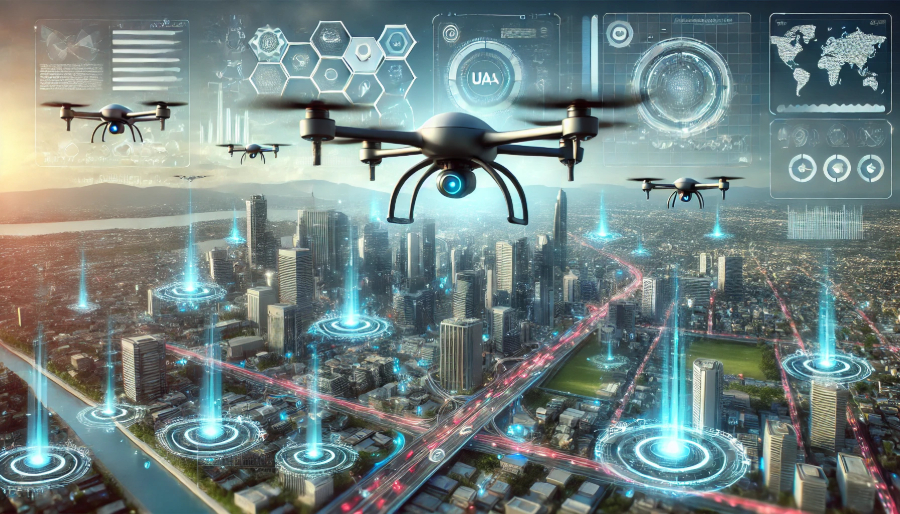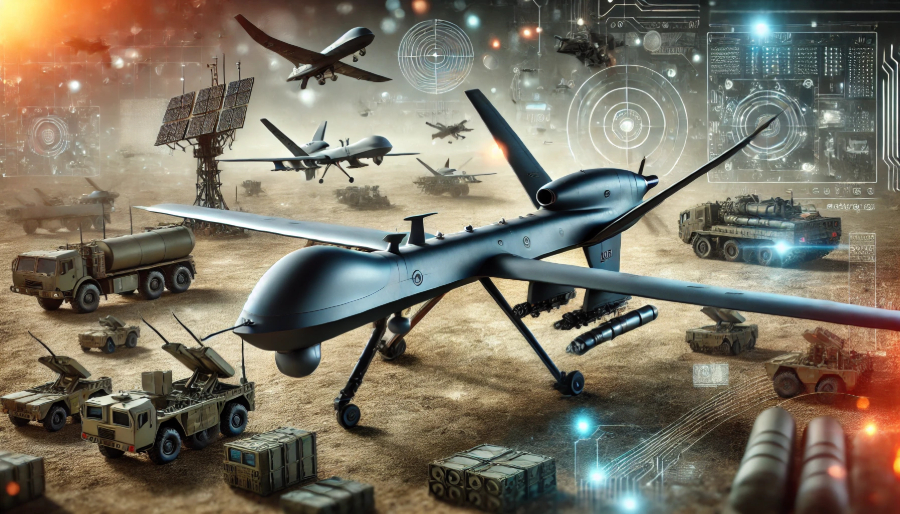The Unmanned Aircraft Systems (UAS) Market is experiencing exponential growth, driven by advancements in automation, artificial intelligence (AI), and miniaturization technologies. These systems, commonly known as drones, are used across various sectors, including defense, commercial, logistics, and agriculture. With increasing demand for autonomous operations and regulatory support, the Unmanned Aircraft Systems Market is set to expand significantly in the coming years.
This blog explores the current landscape, key drivers, challenges, technological advancements, and future opportunities in the Unmanned Aircraft Systems Market.
Market Overview and Growth Trends
The Unmanned Aircraft Systems Market has evolved rapidly, with significant investments in research and development (R&D) to enhance drone capabilities. Originally developed for military applications, UAS technology has expanded into various commercial sectors, including:
- Defense & Security: Surveillance, reconnaissance, and combat operations
- Agriculture: Precision farming, crop monitoring, and pesticide spraying
- Logistics & Delivery: Last-mile deliveries and cargo transportation
- Infrastructure & Construction: Site mapping, aerial inspections, and 3D modeling
- Environmental Monitoring: Disaster management and climate studies
According to market analysis, the Unmanned Aircraft Systems Market is projected to grow at a compound annual growth rate (CAGR) of XX% from 2025 to 2030, with increasing adoption of drones in smart cities and automation-driven industries.
Download Pdf Brochure: https://www.marketsandmarkets.com/pdfdownloadNew.asp?id=18210274
Key Drivers of the Unmanned Aircraft Systems Market
-
Rising Demand for Autonomous Operations
The integration of AI and machine learning has enabled autonomous flight capabilities, making UAS more efficient for commercial and defense applications. -
Regulatory Support and Airspace Integration
Governments and regulatory bodies, such as the FAA and EASA, are working on frameworks to safely integrate drones into controlled airspace, boosting market expansion. -
Technological Advancements in Battery & Propulsion Systems
Improvements in battery life, hybrid propulsion systems, and energy-efficient designs are enhancing the endurance and payload capacity of UAVs. -
Growing Investments in Military UAVs
Defense agencies worldwide are increasing investments in Unmanned Aircraft Systems Market to strengthen surveillance, reconnaissance, and strike capabilities. -
Expanding Use in Commercial & Industrial Applications
The commercial sector is leveraging UAS for inspection, maintenance, and real-time data collection, driving market growth.
Challenges Facing the Unmanned Aircraft Systems Market
1. Regulatory and Safety Concerns
Despite growing regulatory support, stringent rules regarding drone usage, airspace restrictions, and privacy concerns remain key challenges in the Unmanned Aircraft Systems Market.
2. Limited Battery Life and Payload Capacity
Battery limitations restrict flight duration, affecting operational efficiency. However, advancements in hydrogen fuel cells and hybrid propulsion aim to address this challenge.
3. Cybersecurity Threats and Hacking Risks
As UAS become more interconnected, the risk of cyberattacks targeting navigation systems, communications, and data transmission increases.
4. High Initial Costs and Integration Complexities
Implementing UAS technology requires significant investments in infrastructure, training, and software integration, limiting adoption for small businesses.
Key Market Segments
The Unmanned Aircraft Systems Market is segmented based on type, application, and region:
By Type:
- Fixed-Wing UAVs (Long endurance and high payload capacity)
- Rotary-Wing UAVs (VTOL capabilities for surveillance and inspections)
- Hybrid UAVs (Combining fixed-wing and rotary-wing advantages)
By Application:
- Military & Defense (Surveillance, combat, and border security)
- Commercial (Delivery, infrastructure monitoring, and media)
- Agriculture (Precision farming and crop health analysis)
By Region:
- North America (Largest market due to military investments)
- Europe (Strong regulatory support for commercial UAVs)
- Asia-Pacific (Fastest-growing market with high demand in China & India)
- Middle East & Africa (Emerging market with defense and security applications)
Technological Advancements in the Unmanned Aircraft Systems Market
1. AI and Machine Learning Integration
Autonomous navigation and obstacle detection powered by AI are revolutionizing UAS operations. Advanced machine learning algorithms enable real-time data processing and decision-making.
2. 5G Connectivity for Enhanced Communication
The deployment of 5G networks is improving drone-to-ground communication, enabling beyond-visual-line-of-sight (BVLOS) operations and real-time data streaming.
3. Hybrid Propulsion and Alternative Energy Sources
The development of hydrogen-powered drones and solar-energy UAVs is addressing endurance limitations, paving the way for sustainable aerial operations.
4. Swarm Drone Technology
Swarm intelligence is being explored for military applications, where multiple UAVs collaborate in coordinated formations for surveillance and defense operations.
Competitive Landscape
Key Players in the Unmanned Aircraft Systems Market
- DJI (Market leader in commercial drones)
- Northrop Grumman (Advanced military UAV systems)
- Boeing Insitu (Tactical and surveillance drones)
- General Atomics Aeronautical (Predator and Reaper drones for defense)
- Parrot SA (Consumer and enterprise UAV solutions)
- AeroVironment (Tactical UAVs for reconnaissance)
These companies are continuously innovating and investing in next-generation UAV technologies to stay competitive in the Unmanned Aircraft Systems Market.
Ask For Sample Report: https://www.marketsandmarkets.com/requestsampleNew.asp?id=18210274
Future Outlook and Opportunities
The Unmanned Aircraft Systems Market is expected to witness continuous advancements, driven by the following trends:
- Increased Automation in Air Traffic Management (ATM)
- Expansion of Drone-as-a-Service (DaaS) Business Models
- Development of Urban Air Mobility (UAM) Solutions
- Integration of Blockchain for Secure UAV Operations
- Rise of Smart Drones with IoT and Edge Computing
As technology continues to evolve, the Unmanned Aircraft Systems Market will play a critical role in reshaping industries and enabling new business models.
The Unmanned Aircraft Systems Market is at the forefront of technological innovation, with applications spanning defense, commercial, and industrial sectors. Driven by AI, automation, and regulatory advancements, the market is set to experience robust growth in the coming years.
Despite challenges such as regulatory constraints and cybersecurity risks, ongoing R&D investments and strategic collaborations among key players will accelerate market expansion. As the demand for unmanned aerial solutions increases, businesses and governments must adapt to this transformative shift in the aviation industry.
The future of the Unmanned Aircraft Systems Market is promising, offering endless opportunities for innovation and market growth.


